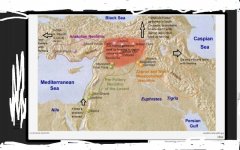MOESAN
Elite member
- Messages
- 5,880
- Reaction score
- 1,291
- Points
- 113
- Location
- Brittany
- Ethnic group
- more celtic
- Y-DNA haplogroup
- R1b - L21/S145*
- mtDNA haplogroup
- H3c
I think as Y-R1 was surely born in Central Asia or not too far, some specific subclades reach Iran and Near-East-South Caucasus through the South Caspian Sea; some gave birth to the famous V88 and yet the precise place of this has to be proved what does not disprove its passage through Near East, others stayed South the Caucasus. But these above mentioned clades are not the ancestors of supposed "steppic" L23 or Z2103 or L51. Just a feeling, not proved at this stage.
It seems the bulk of these last three subclades lived their destiny without too numerous others Y-great haplos among them (R1a, J2 by instance) the R1b-M415 alias L278 of Kura-Araxes Bronze is too poorly defined or of a too "old nature" to tell us too much. Kura-Araxes seems a synthetic culture envolving Uruk people, Caucasians "autochtones" and perhaps some eastern influence of Eastern Caspian, so we are still in balance here.
Concerning EHG genes among CHG, my feeling is that it could be the result of ancient shared ancestral DNA rather than a typical admixture. All the way we see that as time passed the pops drifted and "specialized" or "localized" their auDNA and genuine Iran Neol would have had very little EHG DNA stayed in them, so the new recent EHG DNA has to be come from somewhere else, for I think. But I cannot exclude an other geographical origine than the Pontic Steppes even if it has my preference to date.
It seems the bulk of these last three subclades lived their destiny without too numerous others Y-great haplos among them (R1a, J2 by instance) the R1b-M415 alias L278 of Kura-Araxes Bronze is too poorly defined or of a too "old nature" to tell us too much. Kura-Araxes seems a synthetic culture envolving Uruk people, Caucasians "autochtones" and perhaps some eastern influence of Eastern Caspian, so we are still in balance here.
Concerning EHG genes among CHG, my feeling is that it could be the result of ancient shared ancestral DNA rather than a typical admixture. All the way we see that as time passed the pops drifted and "specialized" or "localized" their auDNA and genuine Iran Neol would have had very little EHG DNA stayed in them, so the new recent EHG DNA has to be come from somewhere else, for I think. But I cannot exclude an other geographical origine than the Pontic Steppes even if it has my preference to date.



